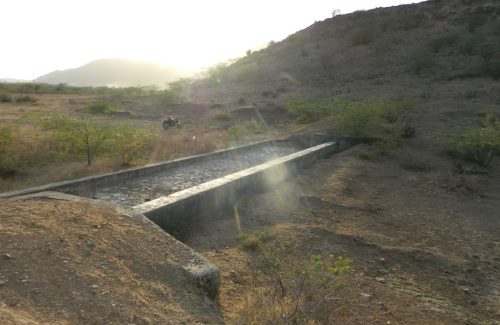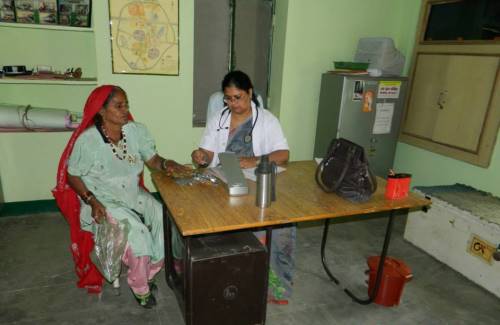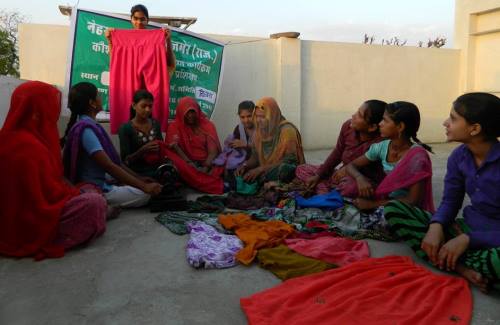What We Do
Natural Resource Management

Since its inception SWERA has concerns for management of natural resources. Agriculture and animal husbandry, the most important means of livelihood sustenance in SWERA’ area of engagement have witnessed constant fall due to perpetual droughts over the years. Moreover, rich Aravali hills are also losing their lustre due to blatant plundering of its natural resources leading to decreasing biodiversity. Many of the medicinal plants like okios have almost disappeared from the rich hills and also from fields in the area.
In earlier days SWERA played a vital role in managing this resource base through its pioneering interventions like construction of watersheds, well deepening, farm bunding, afforestation and pasture land development, baadi development, construction of water harvesting structures, horticulture and so on. Moreover, Village Forest Committees were also formed to ensure people’s participation and sustenance of work done.
Though in contemporary days SWERA has not been taking up any of those construction works due to funding constraints yet it is engaged in promoting biodiversity by planting medicinal and other disappeared species of plants, strengthening Village Forest Committees to better care of its earlier operations.
Besides Environment Protection and Health Committees (EPHC) have also been formed under the strategic name ‘Combating Poverty’. This is a group of children studying at SWERA’s alternative education centres, lending their active support in plantation work, protecting plants, and sensitising people on conservation and intelligent use of natural resources through different street plays and by undertaking different campaigns, viz., plantatin campaign, village cleanliness campaign, etc., which urges elderly people to help them out in their job.
Okiyano criapto, a medicinal plant (also used for pickle making) was available in plenty in the area around 10 years back. But people’s greed endangered the existence of this species by 2003-04. Afterwards, SWERA took the responsibility of conserving this valuable gift of nature. It initiated its movement from a small village called as ‘Hathipatta’ and formed Village Forest Committee over there. It sensitised laymen of the village as well as committee members on importance of this plant and the danger associated with its existence and wooed people to not to harm the same in future. After this, Okiyano criapto was planted on public land of the village and nurtured by people themselves. Now one can easily find a small forest of this species in the village. VFR members are still discharging their responsibilities excellently. Cutting of these plants is completely banned here.
Education

After delivering a child the only thing which perpetually springs to a mother’s mind is the question of better upbringing of her own blood. She pampers her/him a lot, tries to cater even their all trivial needs to make their present comfortable and memorable. But this is only education which enables them in leading their lives with dignity in this highly cut throat competitive era. It makes people humble, teaches them differentiating right and wrong responding t their inner voice, makes them rather logical in their approach, inculcates them with domestic values, broadens the sphere of their vision and eventually prepares them to combat the harsh uncertainty of future. Educating children does not mean only to produce youth capable enough to earn some bucks for leading a comfortable life but to harness their potential so that they become good contributor in the holy task of community development.
In a nation like India where the future of its governance depends more on quantity of voters rather than on their abilities, spreading education among general becomes the task of utmost importance by which they can elect good candidates and deepen roots of democracy.
The organisation strictly believes that apathy of layman towards education is the crux of a string of our socio-economic problems. But at the same time it also adopts ‘education and awareness generation’ as key strategy to struggle with the same.
Free and compulsory education to all children up to the age of 14 years is the Constitutional commitment in India. At the time of adoption of the Constitution in 1950, the aim was set to achieve ‘universalisation of elementary education’ within next 10 years, but in proportion to resources available at that time the goal was highly ambitious and in more appropriate words ‘out of the capacity of state body’.
The deadline to achieve this mammoth target was extended many times. Over the past several decades several gigantic, high budgeted, programmes/campaigns/schemes were launched to bring the goal closure to our reach, but as of today all children in schools is the thing of distant future. The challenge of quality elementary education for all the children in the age group of 6-14 years continues to elude India.
In spite of the remarkable expansion of the elementary education system in the last few decades, around 5.9 million children in Rajasthan in 6-14 age group continue to be out of school. Most of those who enrol in class I do not complete eight years of education. The growing needs of primary education have not been met by all the efforts made so far and there continues to be fairly large gaps in achievement levels.
Of all children enrolled at primary stage, a very high percentage drop out even before reaching class V. Here, the organisation strictly believes that apathy of layman towards education and lack of awareness are the principle contributing factor to this problem. Until the desired changes are brought in prevailing education patterns, empowering a community will remain a dream of distant far.
SWERA’s perspective plan also reflects its commitment towards children’s education by stating that “Educating people is the greatest need of the area to equip them with skills to lead a life with dignity and self respect”
Health

Despite tremendous efforts made by the government to improve the health scenario of the region, economically vulnerable section of the society remains largely excluded from the benefits of all this advancement. It is a well established fact that people from most developing nations which are hard hit regions register shorter life expectancies due to high cost of medical facilities which is out of their paying capacity.
Without adopting a holistic approach of development making differences in lives of rural masses is a pathetic job. In this string SWERA started working in the area of health with the objective of providing primary health care services to rural masses. Initially, the programme concentrated on sanitation and health education issues, but over the years preponderance of our experiences suggested that maternal and child health was still an untouched issue which required more intensive efforts to keep the spiralling IMR and MMR under check. Thus this issue was included and placed at upper most priority stratum of organisation’s health programme. As of today, this programme is reaching out to the target village communities through a health centre erected with handholding support of Population Foundation of India and through a network of Village Health Committees. This committee comprises of Village Health Workers, Traditional Birth Attendants and a few members of Women Health Group.
The programme has been quite successful in creating awareness about hygiene and health issues, but there is a need to focus on the problem of malnourishment among children and tuberculosis with more dedication. In case of our work on maternal and child health we have been more successful through creating and enabling environment towards institutional deliveries in the village.
As stated in its Mission statement “It seeks to develop the rural societies by organising them into groups and providing necessary inputs in the area of education, health, management of natural resources and livelihoods”, the organization has sincere concerns for rural health.
SWERA has worked on:
- Health education
- Reproductive and child health
- Environmental health
It believes that proper environmental management is a key to avoiding the quarter of all preventable illnesses which are directly caused by environmental factors. The environment influences our health in many ways – through exposures to physical, chemical and biological risk factors, and through related changes in our behaviour in response to those factors. Our interventions were aiming at assessment and control of those environmental factors that can potentially affect health. It is targeted towards preventing disease and creating health-supportive environments.
The organisation, under the strategic name ‘Combating Poverty’, shaped children in ‘Environment Protection and Health Committee (EPHC)’, developed SHGs as ‘Working Group on Health’, enhanced their knowledge and skills base through numerous trainings, regular meetings and discussions and deployed them to sensitise people on various environmental health issues such as sanitation, importance of proper drainage system, protection of open wells, reduced use of woods as fuel for cooking, use of scientifically designed ovens which produce lesser smoke and so on.
Children of ‘EPHC’ committees, formed in different villages and members of ‘working group on health’ succeeded in getting traditional ovens replaced with modern one or with LPG operated ovens, promoted use of pressure cookers at a large level. Working group on Health also sensitised masses on cure and prevention of different seasonal diseases, symptoms and prevention of malnourishment among children, importance of ANC, PNC and institutional deliveries, immunisation and so on.
RCH Interventions
RCH interventions are being run through the Health Centre, located in Kanpura village. This health centre is focal point of all RCH. It promotes institutional deliveries and creation of supportive environment for RCH. Various field camps are organised to reach out the remotely located communities. People are provided with free medicines, free checkups, expert counselling on various health issues and so on. Awareness among village communities on dietetic requirements of pregnant women and newborn, importance of institutional delivery, provisions under government schemes to promote safe deliveries and so on is being generated through puppet shows and street plays performed by SWERA team.
To reap the benefits of our tireless inputs restoring the faith of people in government health mechanism was must. After pondering meticulously organisation worked out a new strategy of working in collaboration with government health functionaries for the same. Our VHW and ANM assisted them in reaching out to community to get children and pregnant women immunised, facilitated a dialogue between community and government doctors through different BCC (behaviour change communication) activities. Our VHW also accompanied complicated delivery cases to district maternity hospital and ensured their access to fruits of lucrative Janaji suraksha Yojana.
Livelihood

The origin of microfinance is often dated as the 1970s from Bangladesh. The concept entered India in 1990s and received both wide publicity and success in pushing people out of their poverty. In India, microfinance movement grew up mainly through self help groups and has come out its primary stage, that is, group formation. Success of SHG model shows two things, first, poor are much more credit worthy and they have better repayment records when the group provides the social collateral and second; financial services can be provided to the poor in affordable manner without sacrificing the financial sustainability of the institution.
Sustainable livelihood development has been one of the major thrust areas of SWERA since its inception and it was also very much aware of the fact that microfinance has widely smoothened consumption, reduced the vulnerability of the poor and led to increase in income of poor around the globe. Henceforth, the organisation adopted microfinance as key strategy to cater to people’s small financial requirements and to lift them out of the vicious circle of poverty.
Keeping in view the local situations where women are frequently forced to take responsibility of their entire family SWERA identified women as major target group of its MF programme under various strategic names, presently ‘PEHAL’ and ‘Combating Poverty’.
Under these projects, from the very outset, organisation had concerns towards producing ‘self managed groups’ instead of ‘well managed’ and concentrated primarily on capacity building of its SHGs. Myriad training programmes were taken up to unearth the hidden potential of women. For instance, stitching training, artificial jewellery making training, training of SHG record keeping for leaders, vermicompost training, health training to impart health education and so on.
These training programmes had been quite successful, but not up to the expectations. It was very disappointing but a bitter pill to swallow. However, some women started reaping the benefits of dedicated man hours which they spent developing new and polishing their skills through training programmes. They are not earning abundant amount of money through their nascent enterprises.
Abysmal results of training programmes forced SWERA to undergo a paradigm shift in thinking about the livelihood development of poor especially of SHG women. This is why meticulous discussion is under progress with ARAVALI on entering of SWERA in MRI mode.
Apart from this th eorganisation also came up with a project to strengthen the livelihood nees of poor under the strategic name ‘Family Livelihood Resource Centre’. Under this project 500 poorest families have been identified through PRA to work with and to lift them out of their poverty in a susntainable manner. In days to come these families will be segmented into different groups on the basis of their input neds and then will be provided with different training, exposure, etc., accordingly.
